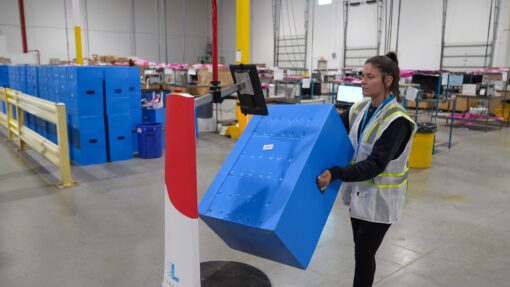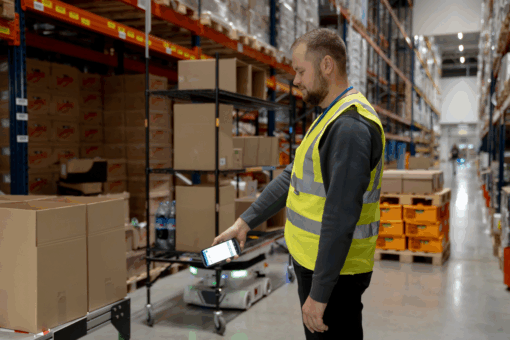WP: How to achieve 400 UPH with Locus Fast Pick
WP: How to achieve 400 UPH with Locus Fast Pick Download Now!
How to Ease the Top Headaches of Manufacturing Warehouses
Mary Hart, Sr. Content Marketing Manager

Manufacturing and industrial warehouses are at the heart of supply chains, ensuring goods reach consumers in a timely manner. However, these facilities face ongoing challenges from unpredictable labor markets to stringent safety standards and growing environmental concerns. It’s a lot for any warehouse manager to juggle. With automation, your warehouse can overcome these obstacles and drive your warehouse into the future.
Labor Challenges in Manufacturing Warehouses
Let's start with one of the biggest headaches: managing your workforce. I'm talking about high turnover rates, neverending recruitment cycles when you can actually find people, and skyrocketing labor costs. Sounds draining, right? Well, here's where warehouse automation in the form of autonomous mobile robots (AMRs) can help!
AMRs work collaboratively with your human associates, taking over those repetitive, monotonous tasks of lugging heavy carts through a warehouse that are prime drivers of burnout and disengagement. By reducing the physical and mental strain on your associates, AMRs help boost worker morale and job satisfaction, which can lead to helping that second warehouse headache.
Reducing Employee Turnover with AMRs
Manufacturing environments also struggle with employee retention and keeping skilled labor due to wage rate wars. By using AMRs, warehouses have reported a significant increase in employee retention due to an improved associate experience. The AMRs take on the majority of the walking in industrial and manufacturing warehouses, and the associates reduce their average daily walking time in the warehouse from 12 miles before the AMRs to under 5 miles. Plus, while the AMRs are carrying material through the warehouse, they don’t stop to chat with colleagues, go to the bathroom, or check their phone.
When you do have new associates join, training time is reduced by 75% or more, thanks to the easy to use operator interface, which is multi-lingual to eliminate any picking errors. Associates also enjoy working with the AMRs and interacting with their workplace digital game board to see how they’re doing each day.
Improving Safety in Manufacturing with Robotics
AMRs also contribute directly to tackling one of a warehouse manager's top priorities — safety. In manufacturing and industrial environments with heavy machinery and manual processes galore, the risks of accidents are all too real. OSHA incidents, especially dreaded forklift crashes, can bring your warehouse operations to a screeching halt while racking up costs in the form of employee injury claims and more.
This is where AMRs roll in to help with your manufacturing warehouse safety. By taking over dangerous material transport and handling tasks, they drastically reduce the need for forklifts and other human-operated machinery. And with their advanced sensor suites like LiDAR, AMRs can deftly navigate around associates to minimize collision risks. Simply put, bringing AMRs into your facility cultivates a safer, more secure environment for your team.
Boosting Throughput Efficiency with Automation
Now, let's talk throughput. For manufacturers, consistently feeding your production lines is make-or-break. Even a brief disruption can cascade into delays, missed shipments, and financial hits. As reliable as your associates are, they simply can't provide the clockwork level of parts delivery alone that they can when working with AMRs.
With their tireless efficiency, AMRs work with your associates to ensure a smooth, uninterrupted stream of orders or materials to keep your product assembly lines working away. AMRs and associates work together to remove bottlenecks and hiccups — instead, you just have a harmonious workflow hitting its targets day in and day out. Increased throughput equals increased revenue, making AMR integration a smart investment, especially when you can scale up as needed with a Robots-as-a-Service (RaaS) model.
A Note on Integration and Costs
While adopting AMRs delivers measurable benefits, warehouse teams should also consider factors like integration time and initial investment. Fortunately, scalable options like Robots-as-a-Service (RaaS) minimize upfront costs and allow facilities to expand gradually. Partnering with an experienced automation provider helps streamline implementation and ensures long-term ROI.
Lowering Industrial Noise Levels with Smart Automation
But what about the subtler quality-of-life factors in warehouses like the incessant industrial noise that grates on your associates and erodes any sense of calm? AMRs have you covered there too because they’re nice and quiet in place of noisy production equipment and industrial tools. This noise reduction slashes stress, boosts productivity, and improves communication and collaboration across your associates.
Enhancing Sustainability Through Industrial Warehouse Automation
With ESG and green practices being such a focal point these days, manufacturers need credible, eco-friendly, and sustainable solutions to stay compliant and conscientious.
From their energy-efficient operation curbing carbon footprints to enabling sustainable recycling and refurbishing programs, AMRs empower warehouses to integrate environmental initiatives seamlessly.
AMRs transform manufacturing warehouses by addressing labor, safety, throughput, and sustainability challenges in one integrated solution. With proven ROI and easy scalability, automation is no longer optional—it’s the next step toward operational excellence.
Ready to learn more? Let’s talk!
Frequently Asked Questions
1) How do AMRs integrate with existing warehouse systems?
Answer: AMRs integrate seamlessly with most WMS and ERP systems, ensuring smooth communication and workflow automation.
2) What’s the ROI timeline for automation in manufacturing warehouses?
Answer: Many facilities see ROI within 12–18 months due to reduced labor costs and improved throughput.
3) How do AMRs improve workplace safety?
Answer: By reducing forklift usage and minimizing manual handling, AMRs help prevent accidents and create a safer environment.




